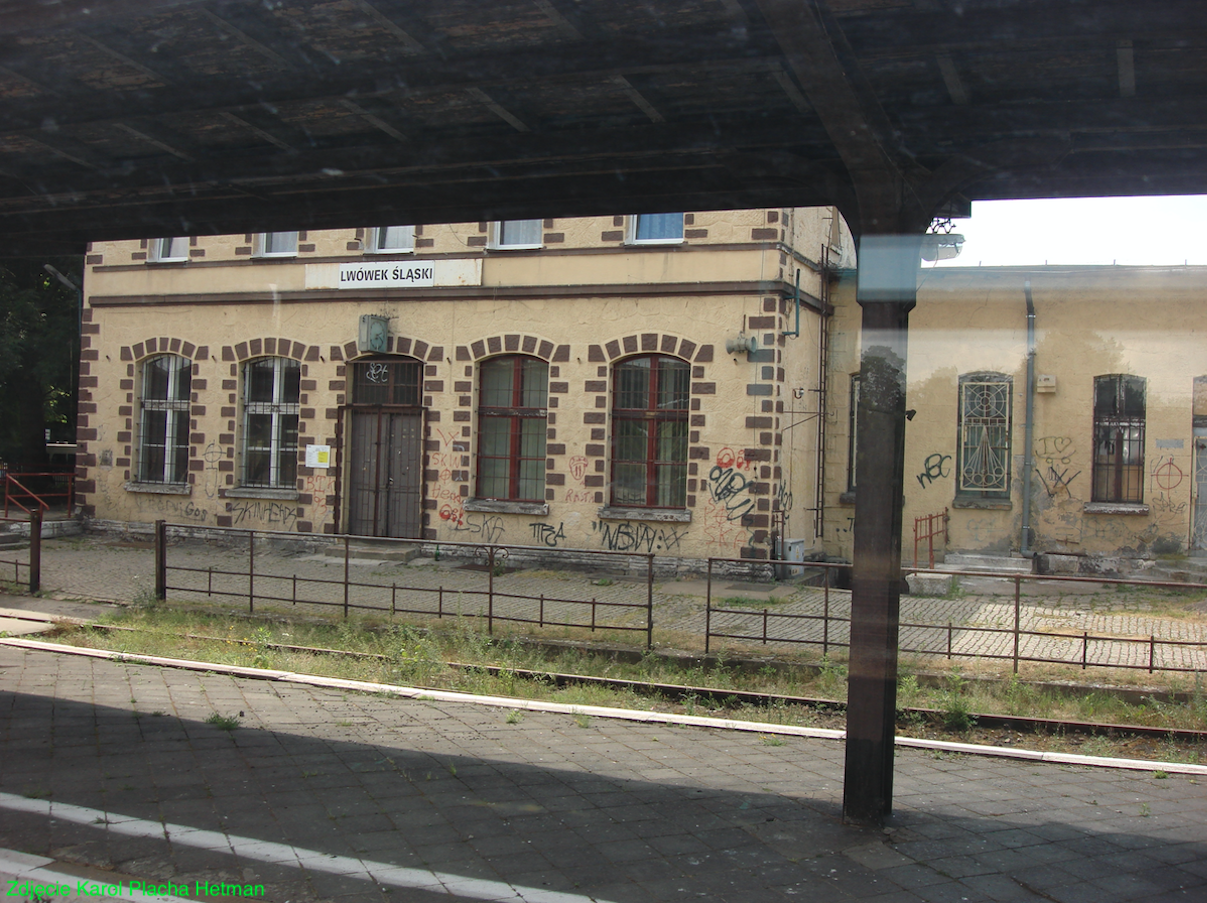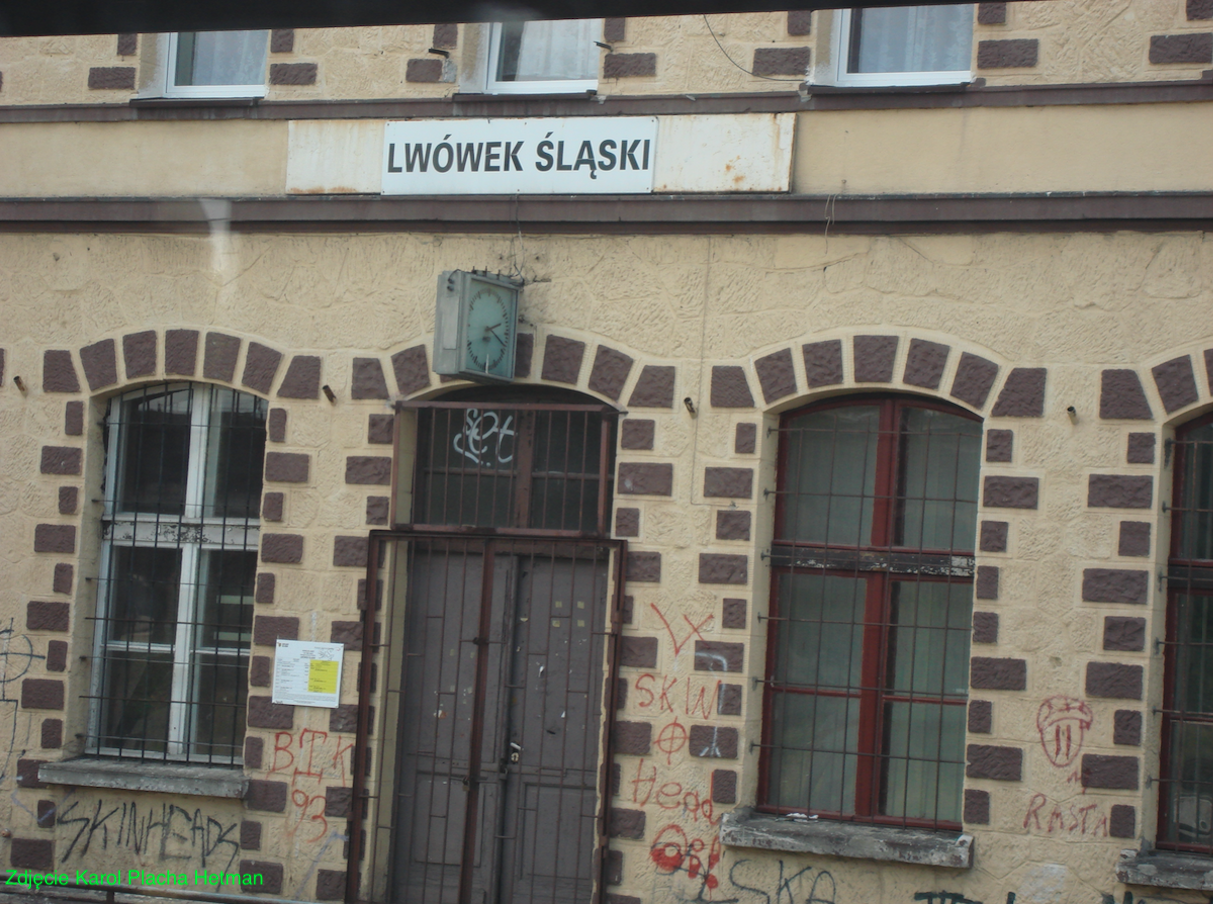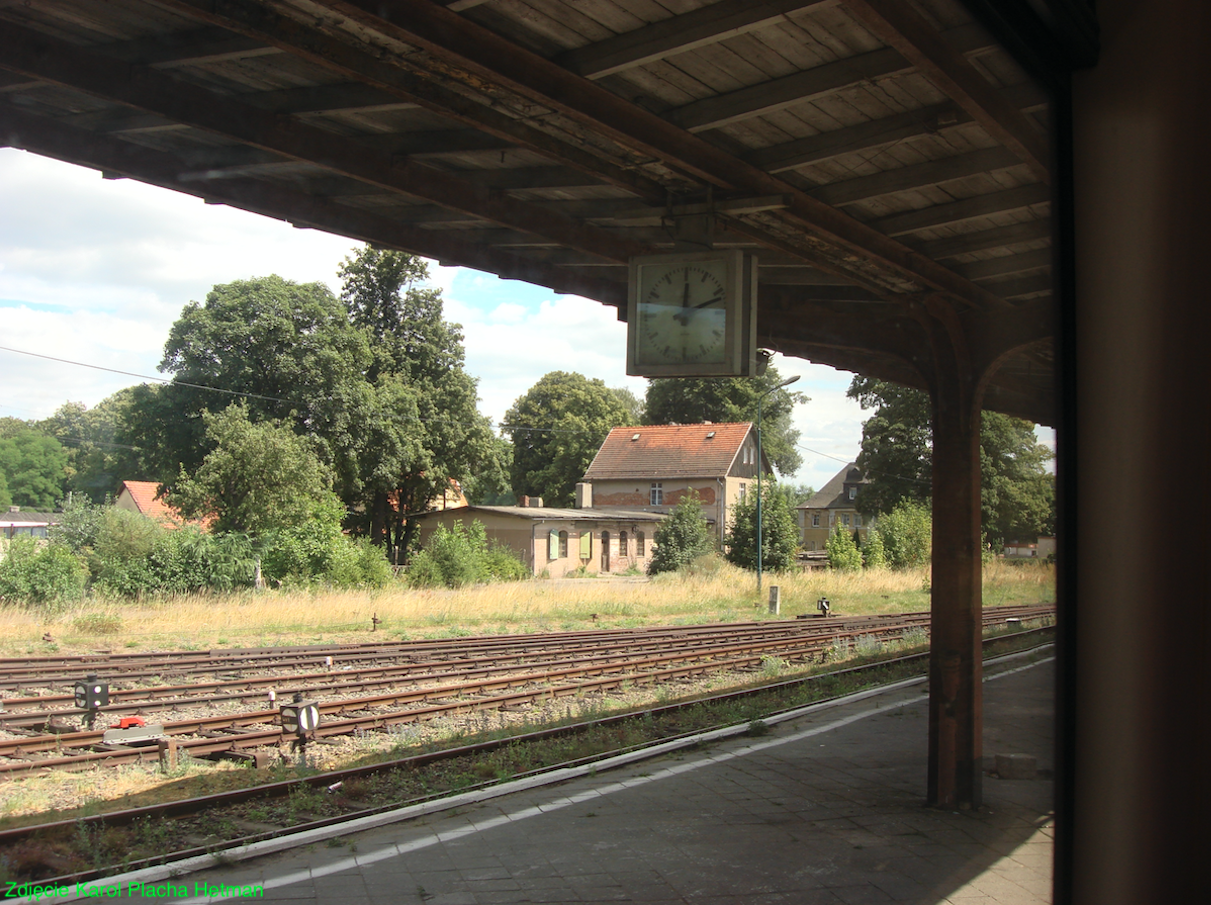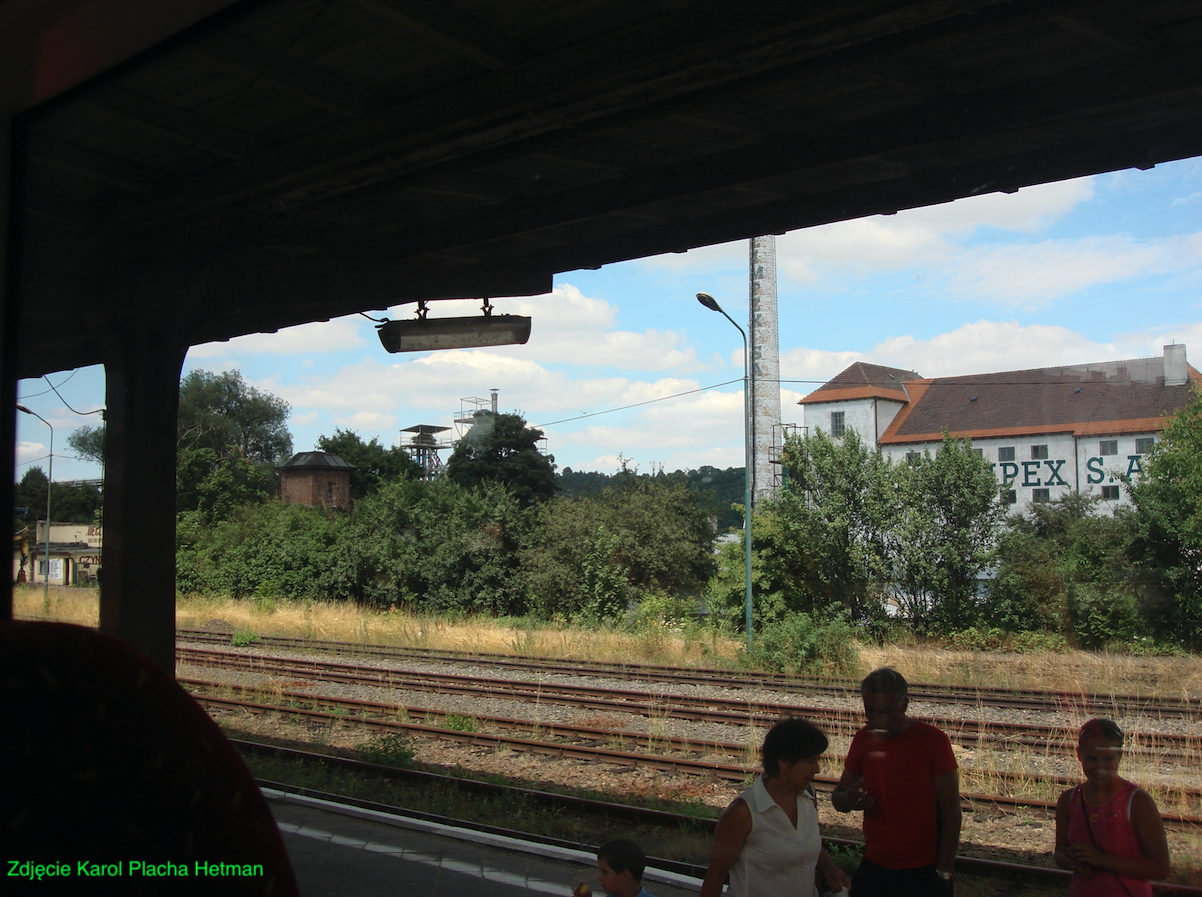Lwówek Śląski 2023-01-25
Lwowek Slaski railway station.
Geographic coordinates: 51.110N 15.592E. Elevation 211 m above sea level.
Currently (2023) there are no passenger trains departing from the Lwówek Śląski station.





Lwówek Śląski.
Lwówek Śląski is a town in Poland located in Lower Silesia, on the left bank of the Bóbr River, on the border of the Izerskie Foothills and the Kaczawskie Foothills. The city has an area of 16.64 km2 and its elevation is 205 - 292 m above sea level. The population of the city is 8,660 inhabitants (2021). Lwówek Śląski is called the Agate Capital of Poland. Valuable specimens of this precious stone have been found here. The current name of the city has been in force since May 7, 1946. Lwówek Śląski is located 20 km from Bolesławiec, 35 km from Jelenia Góra, 115 km from Wrocław and 440 km from Warsaw.
Lwówek Śląski is one of the oldest cities in Poland. Excavations indicate a settlement of at least 700 BC, i.e. the Bronze Age. In 1217, the settlement received city rights. Lwówek Śląski was a royal town. The city was rich, mainly because of the trade law, the organization of fairs and fairs. The city obtained the right to mint its own coin.
As a result of the Second World War, the city of Lwówek Śląski was destroyed in 40% of the buildings, and the devastation and looters reached 75% of the city's infrastructure. On February 16, 1945, the city was occupied by Moscow troops. Interestingly, the double city walls have been almost completely preserved. The great of this world decided that the city and Lower Silesia were incorporated into Poland. But Poland lost Kresy. The local population of the city was displaced to Germany. Poles came to the city, mainly expelled from Kresy. A brewery and other workshops were launched in the city. Beer brewing traditions in Lwówek Śląski date back to at least 1209. The city was also famous for the production of cloth. The economy of the city, both before and after the Second World War, was based mainly on agriculture. There was and is a meat processing plant. In addition to agriculture, small business is also of great importance, as there are several industrial plants in the vicinity of the city. For example, a furniture factory. Deposits of anhydrite, aggregates and building stones, mainly sandstone, are mined near Lwówek Śląski. Since July 22, 2017, a special economic zone has been operating in Lwówek Śląski. In 2019, there were only 200 unemployed people in the city.
In the following years, many buildings and monuments were rebuilt. The town hall is the oldest in Poland, dating back to the 13th century. The oldest church in Lwówek Śląski, dedicated to the Assumption of the Blessed Virgin Mary, dates back to the 14th century. The late Gothic Chapel of the Holy Cross was built in 1496. The Stone Bridge over the Bóbr River in Lwówek Śląski was built in 1558. There is also the Castle in Płakowice from the 16th century.
Railway in Lwówek Śląski.
The railway station in Lwówek Śląski was established in 1885. The ceremonial opening took place on October 15, 1885, when the first train from the Gryfów Śląski station entered the station. The distance between the stations is only 22 km. Lwówek Śląski was then the final station. In the following years, railway routes were laid to Jelenia Góra, Jerzmanice-Zdrój and Zebrzydowa, and the station became a junction station.
Due to the terrain, the station was located east of the Old Town, near the Bóbr River. It is only 500 m from the station to the city center (Town Hall at Plac Wolności, former market square). The pac in front of the station is small and is made up of Dworcowa Street. From the southern side of the station runs the Provincial Road No. 364, which connects DK3 and DK94 in Legnica with DK30 in Gryfów Śląski, 63 km long.
On December 1, 1895, the line was extended eastwards to Nowa Wieś Grodziska. On July 20, 1904, the northern, technically less complicated section of the Bóbr Valley Railway was completed, i.e. the connection to Zebrzydów, to the north. The line Jelenia Góra - Lwówek Śląski was launched in stages: the section Wleń - Lwówek Śląski was put into service on July 1, 1909, and the entire section Jelenia Góra - Lwówek Śląski was ceremonially launched on July 28, 1909. The line was related to the construction of a water dam in Pilchowice. There are three railway tunnels in this section.
In 1909, the Lwówek Śląski station received its current track layout. Two roofed platforms, a tunnel for travelers under the tracks and platforms, and two turntables in both station heads were built. The Lwówek junction was not electrified and all lines were single-track. The construction of the station had a positive impact on the development of the city's economy and tourism.
Lwowek Slaski station in Poland.
After 1945, as a result of border changes, Lower Silesia was granted to Poland as compensation for Kresy. The entire railway in Silesia was taken over by PKP. The first task was the reconstruction of railway tunnels on the Lwówek Śląski - Jelenia Góra section, which were blown up by the retreating German army on May 8, 1945. Some bridges were also damaged. This section was restored to traffic on November 10, 1946.
Due to the specific nature of the railway routes in the Sudety region, low population density and proximity to the borders with East Germany and Czechoslovakia, the railway lines were revalued. In November 1950, the railway connection to Świeradów Zdrój, Leśno and Bogatynia was suspended. Passenger trains to Bogatynia were restored, but travelers had to have special passes. Special regulations were in force in the border area and tourist traffic could not develop.
The communist authorities did not spare Lwówek Śląski either. All trains have been suspended. The intervention of the city authorities in PKP Wrocław resulted in suspension of some connections to Gryfów Śląski and Zebrzydowa stations. Then the traffic to Jelenia Góra was resumed. This suspension was related to the running of some long-distance trains from Wałbrzych and Jelenia Góra north through Wleń, Lwówek Śląski, Zebrzydowa, to Żagań and further. The reason was not loading the cargo route Jelenia Góra - Stara Kamienica - Rębiszów - Gryfów Śląski - Lubań Śląski - Węgliniec with passenger trains. All these trails were single track.
Despite everything, in the period 1960 - 1970, four side tracks, a ramp and a garage for trolleys were built at the Lwówek Śląski station. At the Lwówek Śląski station, the last renovation of the track was carried out in 2013. The station has 4 tracks at the platforms and one side track.
In 1980, trains from Lwówek Śląski ran to: Jelenia Góra - 8 pairs of trains. Świeradów Zdrój - 4 pairs of trains. Legnica - 3 pairs of trains. Węgliniec - 1 pair of trains. Zebrzydowa - 1 pair of trains. Żagań / Poznań - 1 pair of trains. Żagań/Szczecin - 1 pair of trains. Zebrzydowa - 1 pair of trains. Złotoryja - 1 pair of trains. In 2000, trains ran only to Jelenia Góra - 5 pairs of trains. In 2016, passenger trains on this route were suspended.
Railway lines.
In 1983, the running of trains on the route Lwówek Śląski - Mojesz - Pławna Dolna - Pławna Średnia - Pławna Górna - Lubomierz - Oleszna - Gryfów Śląski, i.e. the first route to the city, was suspended. In the following years, individual sections of the trail were dismantled. Currently (2023), from Lwówek Śląski to Pławno Górna, a pedestrian and bicycle path has been made in the former track. In the further part of the trail, traces of tracks and engineering structures, such as some bridges and viaducts, have been preserved. The embankments are used as farm roads. It was the former line No. 284 Legnica - Pobiedna.
On October 1, 1991, passenger connections were suspended on the Lwówek Śląski - Ptakowice - Skorzynice - Nowa Wieś Grodziska section. In 1992, the line was closed down. And on this route, engineering structures have been preserved, such as the riveted bridge over the Bóbr River. The bridge consists of two truss spans and one plate girder span at the northern abutment. The bridge is supported on pillars. There are tracks on the bridge. The total length of the bridge is 97 m. Following the tracks, 400 m, there is another truss bridge "Żabi Rosół" on the floodplain of the Bóbr River. The bridge is 29 m long. Next, there is a viaduct over road No. 25180. The viaduct is in Skorzynice. Further, the railway buildings at the Nowa Wieś Grodziska station have been preserved. The plain of the station was relatively large. Few tracks have survived. Then the trail split. East to Jerzmanice Zdrój and north to Bolesławiec, to be precise to the station Bolesławiec Wschód. It was the former line No. 284 Legnica - Pobiedna.
The Lwówek Śląski - Zebrzydowa trail had more luck. (Line No. 283). On March 31, 1996, passenger traffic was suspended, which was reactivated on December 9, 2007. Passenger traffic was stopped again on December 11, 2011. However, freight traffic is still going on. The railway line is used by the aggregate mine "KSM Rakowice - Gorazdze Kruszywa".
The Lwówek Śląski - Jelenia Góra route (former line No. 283) was maintained in passenger traffic until 2016. It was also a tourist traffic to the dam in Pilchów. Freight traffic was stopped in 2018.
Lwowek Slaski railway station.
The railway station from 1885 is a two-story brick building, without basements, with a flat wooden roof covered with roofing felt. The station has an annex. Currently, it has residential functions. The building originally housed a waiting room, a ticket and baggage office, a restaurant, offices, communication and service rooms, and apartments for railway employees were located on the first floor.
Lwowek Slaski station.
There are two platforms at the station. Both are of the low type and have a height of 0.25 m. The platforms are relatively long, accommodating trains up to 230 m long, but the basic length of the hard surfaced platform is 130 m. The rest is a dirt surface covered with slag. Platform 1 is 235 m long and Platform 2 is 230 m long. Each platform has a 77 m long canopy. The canopy structure is made of metal and covered with boards and roofing felt. There is a tunnel for travelers at the station. Entrances to the tunnel are covered with separate shelters. On the platforms there is a railway information system - audio. The shelters and the tunnel were built in the period 1904 - 1909. The last renovation of the platform 2 shelters was carried out in 2014.
The "LS" signal box is located at the southern head of the station, at the road-railway crossing, along Betleja Street (DW No. 364). The crossing gates are controlled from the signal box. There was also an executive signal box "LS1" in the northern head of the station, but it was dismantled in 2007.
At the station there was a former, four-stand locomotive shed with a turntable, an inspection pit and technical facilities. Around 2005, the depot was sold and no longer serves railway functions. The new owner removed the railway doors and bricked up two of them. He also removed the tracks and turntable. The square in front of the building was covered with asphalt. The building of the technical facilities was also demolished.
There is an unused water tower from 1895 next to the locomotive depot. Closer to the station is the second water tower, built in 1926. The tower has a tank with a capacity of 20,000 liters. The tower is used because it provides water to the surrounding residential houses. The towers were powered by three water cranes.
In its history, the station also had a toilet building, two loading yards, a side-front ramp, a wagon scale, workshop and storage buildings.
Written by Karol Placha Hetman
